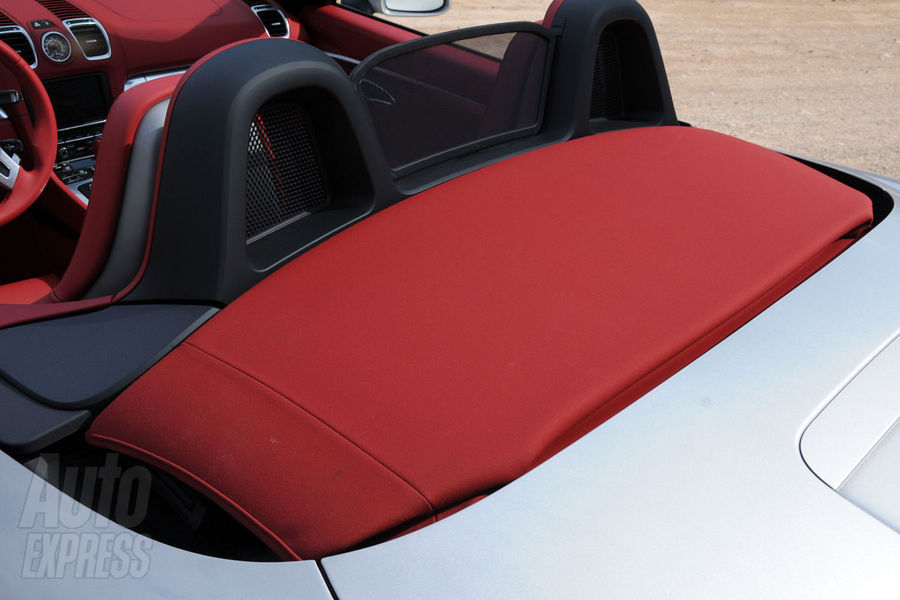Porsche Boxster 3.4 S FIRST DRIVE
Test date 08 March 2012
The new Boxster is more grown up. But still great fun
The new Porsche Boxster "" codenamed 981 "" represents a clear break from the past. A combination of new detailing, a more cab forward silhouette, larger wheel houses (to accept optional 20-inch wheels), distinctive air vents and a rear wing integrated into the tail lamps give the new Boxster a more striking appearance than ever. New underpinnings boasting wider tracks and longer wheelbase provides it with a more confidence stance.
Its mid-engined layout remains, but it retains its architectural links with the latest 911. Porsche wants models to have as much commonality as possible.
Underneath its new lightweight body, the thoroughly re-engineered roadster shares much of its front end structure with the 911, including its MacPherson strut front suspension and all-new electro-mechanical steering.
Inside, the Boxster and 911 share much of their interiors. The new cabin looks and feels modern. The centre feature is the rising centre console. Housing an armada of switches, it also shortens the distance between the gear stick and steering wheel.
The wider, taller and more supportive seats are positioned lower than before and the added space is obvious. With a 60mm longer wheelbase, cabin length "" and seat adjustment - has increased. Tracks widened by 36mm and 6mm front and rear have led to a slight increase in width.
Porsche still offers two naturally aspirated horizontally opposed six-cylinder engines. The 2.9-litre, multi-point fuel engine has been replaced by a 2.7-litre unit with direct injection. Power has increased by 10bhp to 261bhp at 6700rpm, 300rpm higher than before. Torque grows by 7lb ft to 206lb ft on a 400rpm wider band of revs between 4500rpm and 6500rpm.
The Boxster S driven here retains the same 3.4-litre unit, shared with the 911 Carrera. Revisions to the induction and exhaust liberate another 5bhp, taking power to 311bhp at 6700rpm. Torque remains at 265lb ft, but is available across a 200rpm wider range from 4500 to 5800rpm.
A six-speed manual is standard. Porsche expects the optional seven-speed dual-clutch gearbox to be more popular. It has a new electronic control unit for faster shifts and can operate in manual and automatic modes. The gear shift rocker switches still frustrate though. Get the optional shift paddles. You won't be disappointed.
Both units receive stop-start, brake energy recuperation and a thermal management to acheive optimal operating temperature more quickly. A coasting feature reduces engine speeds on prolonged periods of trailing throttle. Porsche claims combined consumption figures of 36.6mpg and 35.3mpg for the Boxster and Boxster S respectively - 15.4 and 14.9 per cent better than the old model.
The classic flat six in the Boxster S is as responsive and memorable as ever, but feels more mature. There is added throttle response, considerable thrust and a stronger feel through the mid-range.
The new Boxster S has a power to weight ratio of 236bhp/tonne, or 230bhp/tonne with the optional dual clutch gearbox. That marks an improvement of around a third over the old car. Porsche claims a 0-62mph time of 4.8sec for the dual clutch-equipped model "" a reduction of 0.2sec. An improved 0.30 drag co-efficient sees top speed increase to 172mph.
There is still a choice of normal and sport modes. The latter enhances throttle mapping and traction control. The electro-mechanical steering, with speed sensitive assistance, is better even than the 911's "" superbly weighted, eager to self centre and direct. The new car is as agile as ever, but its longer wheelbase and wider track aids stability. The front is particularly calm compared to the old model, with less bobbing at motorway speeds.
Its defining factor is still its cornering ability. Crisp, balanced and fluid turn-in from the newly configured chassis and a level of traction unmatched in its class endows the Boxster with a high level of athleticism.
Porsche says the Boxster can achieve 1.2g of lateral acceleration on standard wheels and tyres. It resolutely resists understeer and there is no premature intervention from the standard Porsche Stability Management system.
The ride while firm, is terrifically controlled if not quite as cosseting as some rivals. A new suspension mounting system helps reduce tyre noise, making it a vastly improved long-distance companion.
Porsche Torque Vectoring is offered, but only in combination with Porsche Active Suspension management. In itself, PASM isn't a must-have as the standard setup is so flexible. The standard steel brakes are bang on the money: progressive, high on feel and full of strength.
On first acquaintance, the new Boxster is brilliant and continues to remain one of the world's most entertaining road cars. With an extravagant new look, classy interior, added accommodation, improved performance, engaging handling and improved comfort, you could argue - at the risk of upsetting the legion of 911 fans - that it is now the most complete model Porsche produces.
Porsche Boxster S PDK
Price: tba; Top speed: 172mph; 0-62mph: 5.0sec; Economy: 35.3mpg (combined); CO2: 188g/km; Kerb weight: 1350kg; Engine type:, Horizontally-opposed six-cylinder, 3436cc petrol; Power: 311ps at 6700rpm; Torque: 265lb ft at 4500rpm; Gearbox: 7-speed dual clutch
Test date 08 March 2012
The new Boxster is more grown up. But still great fun
The new Porsche Boxster "" codenamed 981 "" represents a clear break from the past. A combination of new detailing, a more cab forward silhouette, larger wheel houses (to accept optional 20-inch wheels), distinctive air vents and a rear wing integrated into the tail lamps give the new Boxster a more striking appearance than ever. New underpinnings boasting wider tracks and longer wheelbase provides it with a more confidence stance.
Its mid-engined layout remains, but it retains its architectural links with the latest 911. Porsche wants models to have as much commonality as possible.
Underneath its new lightweight body, the thoroughly re-engineered roadster shares much of its front end structure with the 911, including its MacPherson strut front suspension and all-new electro-mechanical steering.
Inside, the Boxster and 911 share much of their interiors. The new cabin looks and feels modern. The centre feature is the rising centre console. Housing an armada of switches, it also shortens the distance between the gear stick and steering wheel.
The wider, taller and more supportive seats are positioned lower than before and the added space is obvious. With a 60mm longer wheelbase, cabin length "" and seat adjustment - has increased. Tracks widened by 36mm and 6mm front and rear have led to a slight increase in width.
Porsche still offers two naturally aspirated horizontally opposed six-cylinder engines. The 2.9-litre, multi-point fuel engine has been replaced by a 2.7-litre unit with direct injection. Power has increased by 10bhp to 261bhp at 6700rpm, 300rpm higher than before. Torque grows by 7lb ft to 206lb ft on a 400rpm wider band of revs between 4500rpm and 6500rpm.
The Boxster S driven here retains the same 3.4-litre unit, shared with the 911 Carrera. Revisions to the induction and exhaust liberate another 5bhp, taking power to 311bhp at 6700rpm. Torque remains at 265lb ft, but is available across a 200rpm wider range from 4500 to 5800rpm.
A six-speed manual is standard. Porsche expects the optional seven-speed dual-clutch gearbox to be more popular. It has a new electronic control unit for faster shifts and can operate in manual and automatic modes. The gear shift rocker switches still frustrate though. Get the optional shift paddles. You won't be disappointed.
Both units receive stop-start, brake energy recuperation and a thermal management to acheive optimal operating temperature more quickly. A coasting feature reduces engine speeds on prolonged periods of trailing throttle. Porsche claims combined consumption figures of 36.6mpg and 35.3mpg for the Boxster and Boxster S respectively - 15.4 and 14.9 per cent better than the old model.
The classic flat six in the Boxster S is as responsive and memorable as ever, but feels more mature. There is added throttle response, considerable thrust and a stronger feel through the mid-range.
The new Boxster S has a power to weight ratio of 236bhp/tonne, or 230bhp/tonne with the optional dual clutch gearbox. That marks an improvement of around a third over the old car. Porsche claims a 0-62mph time of 4.8sec for the dual clutch-equipped model "" a reduction of 0.2sec. An improved 0.30 drag co-efficient sees top speed increase to 172mph.
There is still a choice of normal and sport modes. The latter enhances throttle mapping and traction control. The electro-mechanical steering, with speed sensitive assistance, is better even than the 911's "" superbly weighted, eager to self centre and direct. The new car is as agile as ever, but its longer wheelbase and wider track aids stability. The front is particularly calm compared to the old model, with less bobbing at motorway speeds.
Its defining factor is still its cornering ability. Crisp, balanced and fluid turn-in from the newly configured chassis and a level of traction unmatched in its class endows the Boxster with a high level of athleticism.
Porsche says the Boxster can achieve 1.2g of lateral acceleration on standard wheels and tyres. It resolutely resists understeer and there is no premature intervention from the standard Porsche Stability Management system.
The ride while firm, is terrifically controlled if not quite as cosseting as some rivals. A new suspension mounting system helps reduce tyre noise, making it a vastly improved long-distance companion.
Porsche Torque Vectoring is offered, but only in combination with Porsche Active Suspension management. In itself, PASM isn't a must-have as the standard setup is so flexible. The standard steel brakes are bang on the money: progressive, high on feel and full of strength.
On first acquaintance, the new Boxster is brilliant and continues to remain one of the world's most entertaining road cars. With an extravagant new look, classy interior, added accommodation, improved performance, engaging handling and improved comfort, you could argue - at the risk of upsetting the legion of 911 fans - that it is now the most complete model Porsche produces.
Porsche Boxster S PDK
Price: tba; Top speed: 172mph; 0-62mph: 5.0sec; Economy: 35.3mpg (combined); CO2: 188g/km; Kerb weight: 1350kg; Engine type:, Horizontally-opposed six-cylinder, 3436cc petrol; Power: 311ps at 6700rpm; Torque: 265lb ft at 4500rpm; Gearbox: 7-speed dual clutch




![. [FONT=verdana,geneva"] [FONT=verdana,geneva"]](/forum/styles/default/pcgb/space.gif)









